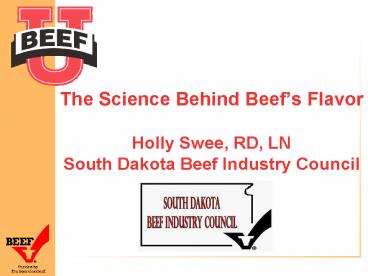The Science Behind Beef - PowerPoint PPT Presentation
1 / 23
Title: The Science Behind Beef
1
The Science Behind Beefs FlavorHolly Swee, RD,
LNSouth Dakota Beef Industry Council
2
Todays Agenda
- Influences on Beef Flavor the Science Behind It
- Tasting Schedule
- Production Methods Beef Choices
- Processor/Foodservice Aging Beef
- Questions
3
Top Factors Influencing Beef Flavor
- Marbling
- Quality Grade
- Cooking Method
- Degree of Doneness
- Postmortem Aging?
- Marinating
- Freezing/Thawing
- Added Flavors
- Beef Production (feeding practices)?
4
2 Flavor Influencers
- Beef Production (producer-feeding practices)
- Grain-Fed/Conventional
- Grass-Finished/Grass-Fed
- Certified Organic
- Natural
- Postmortem Aging (processor/foodservice)
- Wet Age
- Dry Age
5
Different Production Methods More Beef Choices
- Certified Organic Beef
- Natural Beef
- Grass-Finished / Grass-Fed Beef
- Grain-Fed / Conventional Beef
6
LABELING CLAIMSCertified OrganicMust meet
USDAs National Organic Program Standards
- Cattle MUST
- Be raised separately
- Have access to pasture
- Be fed 100 organically grown feed (grains and
forage) - Be treated when sick (Removed from the program)
- Cattle MAY
- Be provided certain vitamin and mineral
supplements - Cattle MAY NOT
- Be given antibiotics or enhancers for any reason
(or must be removed from program)
7
LABELING CLAIMSCertified Organic
- Producers must be certified through USDAs
Agricultural Marketing Service (AMS)
8
LABELING CLAIMSNatural Beef
- Does not contain artificial ingredients
- Not more than minimally processed
- Label must explain natural
- i.e., no added colorings or artificial
ingredients
9
LABELING CLAIMSGrass-Finished Beef
- Feeding regimen for livestock raised on
- Grass, green or range pasture, forage
- Shall be 80 or more of the primary energy source
throughout animals life - Only limited supplemental grain feeding allowed
10
U.S. BEEF PRODUCTIONConventional Beef
- Conventional industry practice
- Cattle raised on pastures
- Grain-based diet in feedlot prior to harvest
- Consumers generally prefer flavor of
grain-finished beef - Most beef available is grain-finished
11
Amount of Omega-3 in Types of Beef vs. Salmon
12
Putting into PerspectiveComparison of a 3
oz coked Top Sirloin steakCalculations derived
using data from Leheska et al., Journal of Animal
Science 2008
Component DV/ Rec Grain-Fed Grass-fed
Total Fat 65 g/d Daily Value 3.7 g 6 DV 2.4 g 4 DV
Omega-3 285 mg/d AHA 7 mg 2.5 26 mg 9
Total CLA 600-3400 mg/d Science 18 mg 3 20 mg 3
13
(No Transcript)
14
Postmortem Conversion of Muscle to Meat / Aging
Beef
15
Life-Giving Protein-Muscle
- Muscle is primarily water and protein
- 72 water
- 20 protein
- 7 fat
- 1 minerals
- 3 muscle proteins
- Myofibrillar Proteins-Myosin Actin (salt
soluble) - Stromal Proteins-Connective tissue -Collagen
Elastin - Sarcoplasmic Proteins-glycolytic
enzymes-Myoglobin Hemoglobin (oxygen binding)
16
Postmortem Conversion of Muscle to MeatBundle of
Muscle Fibers
17
Thick Thin Filament structure of the Myofibril.
Thick primarily Myosin and Thin primarily Actin
18
(No Transcript)
19
Aging
- Protease-Enzyme begins protein catabolism by
hydrolysis of peptide bonds. - A natural enzymatic process that occurs in all
muscles after harvesting - To download a copy of Industry Guide for Beef
Aging, visit
- www.beefresearch.org/FeaturedResearch.htm
20
Aging Beef
- Postmortem Aging (processor/foodservice)
- Wet Age
- Dry Age
21
Dry vs. Wet Aging
Wet Aging Dry Aging
Vacuum Bags Uncovered
Under Refrigeration Under Refrigeration
N/A Controlled Humidity Air Flow
Up to 21 Days Up to 28 Days
Tenderness Increases Tenderness Increases
Traditional Flavor Distinctive Brown-Roasted Beefy Flavor
Yield Loss less than 1 Yield Loss 4-19
Less Expensive than Dry Aged More Expensive than Wet Aged
22
Questions
23
Funded by The Beef Checkoff


























![READ [PDF] The Wok: Recipes and Techniques PowerPoint PPT Presentation](https://s3.amazonaws.com/images.powershow.com/10063316.th0.jpg?_=20240624098)




